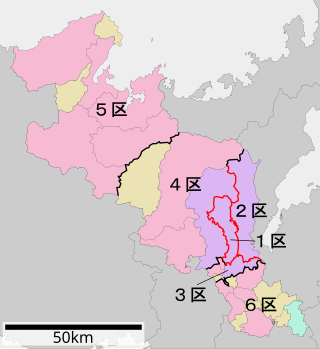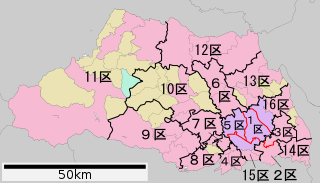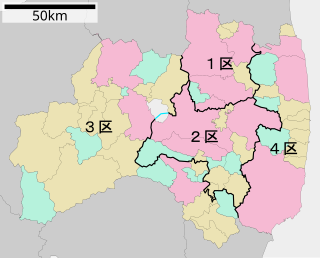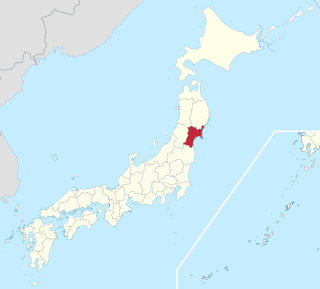
Taihaku-ku (太白区) is the southernmost ward of the city Sendai, in Miyagi Prefecture, Japan. As of 1 March 2023, the ward had a population of 234,391 and a population density of 1028 persons per km2 in 113,068 households. The total area of the ward was 228.39 square kilometres (88.18 sq mi). Taihaku-ku is eleventh largest ward in Japan in terms of area, and second-largest in Sendai. The western portion of the ward is the former town of Akiu, Miyagi.

Kanagawa 11th district is a constituency of the House of Representatives in the Diet of Japan. It is located in Kanagawa Prefecture, and consists of the cities of Miura and Yokosuka. Former Prime Minister of Japan Junichiro Koizumi served as the first representative of the constituency from its creation in 1996. Koizumi retired at the 2009 elections and his son Shinjirō ran as a candidate for his father's old seat. The Democratic Party of Japan fielded Katsuhito Yokokume, a lawyer and former participant in the Ainori TV show, as a candidate in 2009 to a bid to end the LDP dominance of the district.
Tokyo Tokyo city district was a constituency of the House of Representatives in the Imperial Diet of Japan. Between 1902 and 1917 it elected eleven representatives by single non-transferable vote (SNTV). It was located in Tokyo and consisted of Tokyo City. Tokyo city often elected (anti-mainstream) Kenseitō, Kokumintō, Dōshikai and independent politicians while few Seiyūkai politicians managed to be elected among the top five. Exceptions were Hatoyama Kazuo and his son Ichirō who in 1917 managed to achieve top tōsen, i.e. be elected with the highest vote. Other prominent representatives from the city of Tokyo include economist Taguchi Ukichi, Bukichi Miki, Kenseikai secretary-general in the 1920s and co-founder of Hatoyama's postwar Japan Democratic Party in 1954, and Tanomogi Keikichi, Minister of Communication in the 1930s and mayor of Tokyo.
Tokyo's 1st district was a constituency of the House of Representatives in the Diet of Japan. Between 1947 and 1993 it elected four, later three representatives by single non-transferable vote. It initially consisted of Tokyo's Chiyoda, Chūō, Minato, Shinjuku, Bunkyō and Taitō special wards. In the 1964 redistricting Chūō, Bunkyō and Taitō were split off to form the new 8th district.

Tokyo 2nd district is a constituency of the House of Representatives in the Diet of Japan. It is located in eastern mainland Tokyo and covers central parts of the former Tokyo City. The district consists of the wards of Chūō, Bunkyō and Taitō. As of 2012, 424,273 eligible voters were registered in the district.

Kyōto 2nd district is a constituency of the House of Representatives in the Diet of Japan. It is located in central Kyoto and consists of the Kyoto city wards of Sakyō, Higashiyama and Yamashina. As of 2012, 267,926 eligible voters were registered in the district.

Kyōto 3rd district is a constituency of the House of Representatives in the Diet of Japan. It is located in South central Kyoto and consists of Kyoto city's Fushimi ward, the cities of Mukō and Nagaokakyō and the town of Ōyamazaki. As of 2012, 345,260 eligible voters were registered in the district.

Saitama 3rd district is a constituency of the House of Representatives in the Diet of Japan. It is located in Southeastern Saitama and consists of the cities of Sōka and Koshigaya. As of 2012, 460,884 eligible voters were registered in the district.

Ibaraki 4th district is a single-member constituency of the House of Representatives in the Diet of Japan. It is located in Northern Ibaraki and consists of the cities of Hitachinaka, Hitachiōta, Hitachiōmiya and Naka and the town of Daigo. As of 2021, 268,147 eligible voters were registered in the district.

Fukushima 3rd district is a single-member constituency of the House of Representatives in the Diet of Japan, located in Western Fukushima Prefecture. The electoral district lies mostly in the Aizu region and consists of the cities of Aizuwakamatsu, Shirakawa and Kitakata and six districts: Minamiaizu, Higashishirakawa, Yama, Kawanuma, Ōnuma and Nishishirakawa. As of 2012, 293,378 eligible voters were registered in the district.
Mie 3rd district is a single-member constituency of the House of Representatives in the Diet of Japan. It covers Northern parts of Mie, namely parts of Yokkaichi, the cities of Kuwana and Inabe and the counties of Kuwana, Inabe and Mie. As of 2012, 339,451 eligible voters were registered in the district.

Ōsaka 7th district is a single-member constituency of the House of Representatives in the national Diet of Japan. It is located in Northern central Ōsaka and covers the cities of Suita and Settsu. As of 2012, 352,998 eligible voters were registered in the district.

Ōsaka 19th district is a single-member electoral district for the House of Representatives, the lower house of the national Diet of Japan. It is located in southern Osaka and consists of the cities of Kaizuka, Izumisano, Sennan, Hannan and the towns of Kumatori, Tajiri and Misaki in the former county of Sennan. As of September 2012, 307,237 eligible voters were registered in the district.

The Miyagi at-large district is a multi-member constituency that represents Miyagi Prefecture in the House of Councillors in the Diet of Japan. It currently has two Councillors in the 242-member house, but this representation will decrease to two at the next election, to be held by July 2019.

Miyagi 2nd district is a single-member constituency of the House of Representatives, the lower house of the National Diet of Japan. It is located on the island of Honshu, in Miyagi Prefecture, and includes parts of the city of Sendai, the prefectural capital.

Nagasaki 4th District was a single-member electoral district for the House of Representatives, the lower house of the National Diet of Japan. It was located in western Nagasaki and consisted of the cities of Sasebo, Hirado, Matsuura and Saikai, as well as Kitamatsuura District. As of 2021, 250,004 eligible voters were registered in the district.

Miyagi Prefecture 6th District was an electoral district for the Japanese House of Representatives. The district was established In 1994 as a single member district from most of Miyagi 2nd district.

Kanagawa 1st district is an electoral district in the House of Representatives of Japan. The district was established in 1994 as a single-member constituency.

Oita 1st District is an electoral district in the Japanese House of Representatives. The district was established as a single-member constituency in 1994 from parts of the original 1st district.

Tokyo 20th District is an electoral district of the Japanese House of Representatives. The district was created in 1994 as part of the move to single-member districts that same year, and the district is currently represented by the Liberal Democratic Party's Seiji Kihara.














